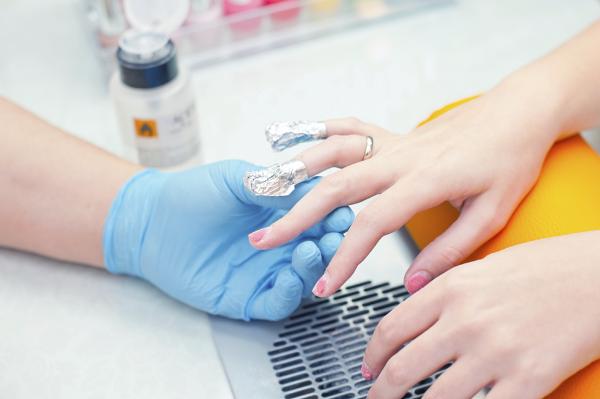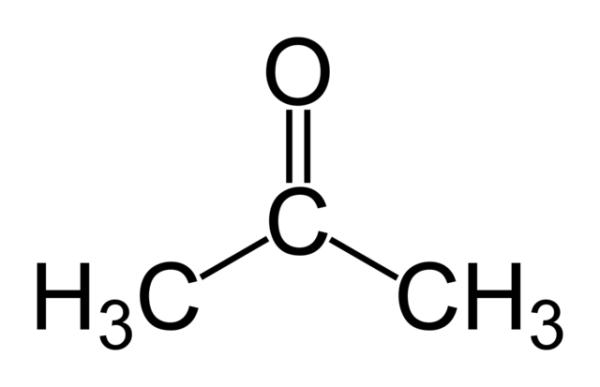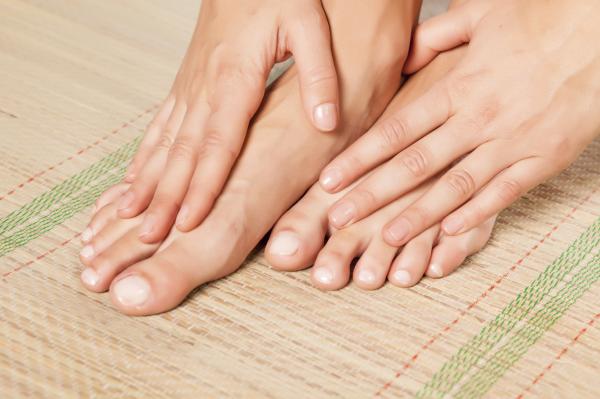Acetone Uses On Skin


Acetone is a solvent that is used as the active agent in nail polish removers. When you enter a nail salon, you can easily identify the distinct smell of acetone. Nail polish isn't the only thing it can remove, it is also effective in getting rid of paint stains, superglue, skin adhesive and permanent marker. Until recently, it has found its way into a number of cosmetics and skin care products as well. It is used in a variety of cosmetic applications and chemical peel products, but in reality, acetone is a potentially hazardous product to use on your skin. This oneHOWTO article is going to discuss some acetone uses on skin and their prospective dangers.
Acetone structure
Acetone is a flammable, transparent liquid that has the volatile property to evaporate quickly. Its chemical formula is (CH3)2O. Due to the presence of carbon atoms in it, it is an organic compound by nature. It contains three atoms of carbon, six atoms of hydrogen and one atom of oxygen.
Acetone is classified as a ketone. Ketones are organic compounds which contain carbonyl groups bonded to a couple of hydrocarbon groups. The carbonyl group of acetone has a double bond of oxygen and carbon, making it one of the simplest ketones. Due to its solvent nature, it dissolves other substances and is very successful in removing nail polish, paint and other hard-to-remove compounds.

Uses of acetone on skin
Over the last few years, people have started using acetone in their skin care routine. Acetone has immediate cleansing effect, but this may not be the only effect it has on your skin. Whether they are good for you or not, many people use acetone on their skin for the following uses:
- When you apply a little amount of acetone on your skin, you will see that it evaporates quickly and your skin is left extremely dry in that area. Due to this drying effect, dermatologists use it during chemical peels before skin exfoliation. Using acetone, they can first clean the skin to remove excess oil and fat.
- Because of acetone's immediate drying effects, some people apply it on their acne to dry them quickly and remove them. When you apply acetone on open sores like acne, you feel extreme irritation and burning sensation, but some people accept that in return for the acne healing effects it seems to provide.
- Acetone is also mixed in a number of skin peels. You apply the peel on your skin and let it sit for 10-15 minutes. As it dries up and evaporates, it is believed to soak up impurities and excess oil from your skin as well. When you remove the peel, you get an immediate improvement in your skin complexion. These are chemical peels and are normally carried out by a practising cosmetologist. This due to the relative volatility of acetone.
- Sometimes, you may mix acetone in your face pack to have an even skin tone. If you have scars or spots on your skin, acetone may make them look lighter by drying them and removing residue from them
- Adorning hands with gel or acrylic nails is a fashion these days, but when it comes to removing them, you need to soak your fingers in acetone. Soaking can cause the acetone to seep through your skin and reach your blood stream. This can have devastating effects not only your skin, but on your overall health.
How dangerous is acetone for skin
Chemical form of acetone is found in many different places, and it is naturally produced by human body as well. As it is miscible, meaning it can be mixed with water, there are many products which might contain it in diluted form. This provides many chances for your skin to come in contact with acetone in any form. This is why it is considered an irritant and you should see an 'X' symbol on the bottle to show you it has this quality.
Acetone in small amounts does not usually cause any harm, even if it gets absorbed through the skin and enters the blood stream. But at high concentrations, acetone can cause extreme redness, irritation and dryness on skin. If you continue applying acetone on your skin for a long time, it may develop dermatitis. It may also cause tissue damage in your body if you are exposed to acetone in high amounts. If acetone is a solvent which can dissolve superglue, it implies that it might not be the nicest treatment for your skin, especially with prolonged exposure.
Naturally present acetone in human body
Minimal or brief exposure of skin to acetone is not likely to cause any harmful effects. In fact, the human body naturally produces small amounts of acetone after breaking down fat. Some plants also produce acetone. Traces of acetone are also present in the environment due to its industrial chemical applications. The amount of acetone present in human body may vary from one individual to the other.
Pregnant women and people who exercise more are likely to have more acetone than others. Most of the naturally present acetone is broken down and metabolized in the body. Some of it is also passed out of body during breathing and urinating. Therefore, if you happen to absorb a small amount of acetone, it is not likely to cause any noticeable harm. However, applying large amounts of acetone directly on the skin can be dangerous.

Dangers associated with using acetone on skin
Unless you work in a laboratory or somewhere acetone is used in large quantities, it is unlikely you will absorb significant amounts of it through skin. However, if you purposefully choose to use acetone on your skin as a treatment, its effects can be harmful. Continued exposure to it can be dangerous in many ways. Let’s see how:
- People who work with acetone and regularly come in direct contact with it can develop very dry skin over time, as it removes fat from their tissue. Exposed areas of their skin also become very itchy and red. With prolonged exposure, some individuals may develop dermatitis as a result of chronic itching and irritation caused by the drying properties of acetone.
- Since acetone may get absorbed into your blood stream and reach different parts and organs of your body, it is likely to cause a number of health issues with significant exposure to acetone. It may affect your central nervous system, and lead to symptoms like drowsiness and dizziness. It may also lead to nausea and headaches in some individuals. Although it is not possible to absorb huge amounts of acetone through skin quickly, if done, it can lead to coma and death.
- When you remove your nail polish regularly with acetone, you must have noticed that your nails become damaged, super dry and brittle. That is why experts recommend to remove the nail polish and let your nails breathe at least once in a while. Most of the damage done to your nails is not due to the nail polish, but due to the acetone that you use to remove it. Nail polish can actually provide a protective layer to your nails. Not using acetone for a few days can give your nails some time to recover from the damage done.
- If you have separated or lifted nails from their nail bed, you should never use acetone on them. The solvent properties of acetone will soak into the exposed nail beds and cause extreme irritation. It may also cause further nail separation in some cases. Even if you apply it over the nail polish, acetone may dissolve the nail polish and seep in to enter your nail bed. So, be cautious.
- Many gel manicures require you to soak your hands in acetone for around 10 minutes. This can be extremely damaging and drying for your skin, and can lead to short-term side effects of acetone, such as dizziness, nausea and headache. If you regularly go for a manicure or do it at home, opt for a non-gel based procedure instead of a gel one which requires use of acetone.
- Using acetone for acne (or any part of the body) is ill-advised. Even if you don't cause irritation or discomfort on the exposed skin, it is a drying agent. If you put it on acne or broken skin, the drying effect will only make the recurrence of acne more likely.
If you want to read similar articles to Acetone Uses On Skin, we recommend you visit our Beauty & Personal Care category.






